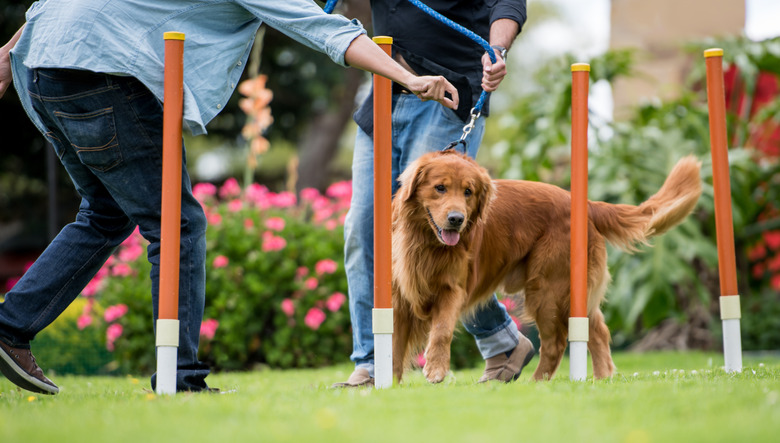Which Kinds Of Dogs Are The Least Work?
So you want a dog, but you also accept that you are a busy human who maybe doesn't have the ideal life set-up for getting a dog. Maybe you work long hours. Maybe you live in a small-ish apartment. Maybe you just know that you're a low-energy person and you're worried about adopting a dog that's too high energy for your life. Maybe it's a combination of those things.
Whatever your "I'm not _____enough to be a dog owner" fear(s), know that there is a pupper out there for you and your life. Here's what you need to know about the kinds of dogs that are, for lack of a better term, the least work. Some examples include French bulldogs, Pomeranians, and dachshunds.
Low grooming requirements
Low grooming requirements
When we talk about dogs not being a lot of "work," we're talking about dogs that are low-maintenance relative to other breeds. Some dogs have coats that require constant grooming or reserves of energy that require daily runs to burn through, for example. When it comes to the grooming question, there are several breeds that are low-maintenance in terms of beauty upkeep. This includes mostly short-haired dogs such as beagles, Boxers, Doberman pinschers, Great Danes, and some lesser-known breeds, like Weimaraners and vizslas.
Low time and energy needs
Low time and energy needs
If your definition of "work" comes down to an issue of time, there are also dogs that require less attention than others. Chow chows, for example, aren't super affectionate as a breed, so they won't be crippled by depression if you have to work late the way a lab might.
You can also look for low-energy breeds, like basset hounds, which are more likely to be perfectly happy sleeping the day away while you're at work and then embracing the cuddles when you are around. Pomeranians are another great breed for the time-stretched since they're pretty independent as dogs go and not likely to freak out over having some extra alone time.
Best dogs for apartments
Best dogs for apartments
Several factors come together to make a dog well-equipped for apartment life. You might think that the size of the dog is the biggest factor when it comes to their apartment-living suitability, but that isn't necessarily the case (although, even many pet-friendly rentals do impose size and weight limits on dogs that are allowed to live there).
Size really shouldn't be your only consideration, since there are lots of low-energy large dogs that might be better suited for apartment life than smaller dogs who need more space because they're constantly running to burn off their high levels of energy.
Some great dog breeds to consider if you live in an apartment include dachshunds, which are very cuddly and relatively low-energy, making them perfect for small spaces, or French bulldogs, who are notoriously laid back.
Another factor? How the dog will interact with other people. A dog who lives in a house might only really be exposed to their own human family, but an apartment dog is definitely going to end up interacting with (or, at very least, passing by) other residents. Make sure to choose a dog that won't bother your neighbors by barking incessantly and who will be polite when meeting new people.
If you know your apartment dog will have to interact with a lot of neighbors, consider a pug. The breed is known for being highly adaptable, which makes them adept at making friends with strangers (and a rotating crew of neighbors). Another neighbor-friendly dog is the Cavalier King Charles spaniel, which is quiet and great with strangers and kids. The Havanese is another great option, since they are friendly and easy on anyone who might have dog allergies.
Considerations when adopting a puppy
Considerations when adopting a puppy
If your biggest reason for needing a low-maintenance dog is time, then breed shouldn't be your only concern. In fact, there's a good case to be made, in this case, for breed not even being your main concern. If you're strapped for time, age might actually be the biggest factor you should consider in choosing your doggo companion.
Why? Well, first and foremost, while a puppy is tempting, they're also a ton of work. Yes, they're incredibly cute, but like babies, that cuteness is part of their biological defense against being abandoned by their caregivers because they are really, really difficult sometimes (this might not be a scientific claim, but you know the logic makes sense on a gut level, right?). And, unlike babies, who can at least be contained in their cribs, puppies can already walk and get into all kinds of trouble.
And then, of course, there's the most obvious puppy problem: Potty training. It takes a lot of time and dedication to potty train a dog and if you don't have the time to do so, you might be setting yourself up for a lifetime of accidents, which isn't ideal. Other puppy-specific issues include the zoomies (the tendency to run like a madman for no apparent reason to burn off energy), teething (and the furniture-chewing that often goes along with it), and the need to do other basic training and socialization, all of which takes time.
Choosing an adult dog
Choosing an adult dog
Older dogs (think dogs who are five and up), tend to be pretty chill, relative to puppies of their breeds. Their personalities are more or less set, which means that you'll know more or less what to expect going forward (unlike puppies, who are still finding themselves, so to speak).
Contrary to popular opinion, older dogs aren't "damaged goods," either. Your local shelter can help match you with a dog who matches your personality and needs and, if you don't have the time to dedicate to a dog with special health or behavioral needs, your shelter won't want to match with you that kind of dog anyway, since the likelihood of it ending up right back in the "system" is so high.
Other benefits of adopting an older dog include cost—not only is it often cheaper to adopt the dog in the first place, but vet bills are usually smaller, since older dogs don't require the early battery of vaccines that puppies need—and the fact that they're often already potty-trained and may know basic commands already.
Canine temperament considerations
Canine temperament considerations
There are a lot of different temperaments a dog can have, but in general, some of the most common will be Laidback/Happy, Confident/Independent, Timid/Fearful, and Aggressive. The good news is that there are ways to assess a dog's temperament before you adopt, maximizing the chances that the pairing will be a good fit.
First, clearly, you'll want to ask about the dog's known history. Depending on the dog's personal backstory, the shelter may or may not know much about it, but they should be willing to share any health or behavior information (like known incidents of aggression) with you.
Next, you can perform a series of simple tests to asses the dog's temperament. These tests should be performed with a professional around if possible (this could be a trained employee at the shelter or an outside trainer or dog behavior expert that you could hire to come along with you) and should, ideally, be performed at least twice on different days, to account for the possibility of the dog having an "off" day (which could mean an atypically good as well as an atypically bad day) when you first perform the assessment.
Initial dog temperament assessments
Initial dog temperament assessments
There are several simple assessments that will help you get a feel for a dog's temperament. The first sounds simple and obvious but is vitally important. Approach the dog slowly, calmly, and while speaking in a soft voice. Ideally, the dog will display friendly signals (like wagging its tail) and welcome you into its personal space. If the dog reacts with aloofness or timidity, you can keep going with the tests, but if the dog is immediately aggressive (and tries to bite or assert dominance), its probably not ready for adoption—at least not by someone who is looking for a low-maintenance pet.
If the dog lets you into its personal space, the next step is gentle petting. Again, ideally, you're looking for enthusiastic acceptance—a wagging tail, sweet kisses, etc.—but know that a Timid/Fearful dog might shy away at first and that a fiercely independent dog might not. Aggression would be a bad sign here.
If you've gotten this far, try to give the dog a gentle physical exam—touch and look at its ears, lift its tail, tough its paws. Even Laidback/Happy dogs will probably squirm and resist a bit, but if the dog lets your get up close and personal like this, then you know the temperament is probably very much in the chill category.
Other assessments before you adopt
Other assessments before you adopt
If you adopt this dog, you'll need to walk it on leash and some dogs react very differently to being on a leash than to being "free" so to speak. Take the dog on a test walk on lead to see how he or she behaves. Laidback/Happy dogs will usually walk along with you no problem, while Shy dogs might freeze and Independent dogs might resist and pull at the leash. Putting on a leash can also be a trigger that reveals aggression in Aggressive dogs, so it's good to test it out before you adopt.
Finally, try feeding the dog a meal. While this is less likely to reveal a ton about dogs in the Laidback, Shy, and Independent categories, food aggression is a real thing and feeding a meal can reveal a lot about a dog who is inclined to be territorial or aggressive at meal times. This is especially important to note if you have other pets or small children around. If you have other pets or children in the home, introduce them to the new dog before finalizing the adoption to ensure everyone gets along.
Adopt a trained dog
Adopt a trained dog
This one is pretty easy. If you're looking for a dog that is trained in the most basic sense of the word, you can simply ask the employees at your local shelter to introduce you to dogs who are already housebroken and who know some basic commands like sit and down. Not every dog who is up for adoption will be trained, but some, especially older dogs, will already know some basics.
If you're looking to go beyond that, you can apply to adopt a "failed" service animal. The training programs for working dogs are intense and not every puppy who starts the training process is able to complete the rigorous programs. Those dogs are released to people and families looking to adopt loving, well-trained pets.
If this option appeals to you, you should search for service dog training programs and organizations in your area and inquire about opportunities to adopt dogs that don't complete the program. Note that this process will almost definitely take time, as the waitlists to adopt these dogs can be quite long in some cases.
Other factors to consider
Other factors to consider
Other factors that can make a dog a lot of "work" for its owner include known health issues, like chronic illnesses or disabilities, separation anxiety (which can cause a dog to bark excessively or even make itself sick when left alone), and special dietary restrictions (which can be expensive and time-consuming if you have to go out of your way to buy special food or cook for the dog at home). These are all important factors to consider when adopting a dog that will fit into your life.
References
- American Kennel Club: 7 Dog Breeds With Minimal Grooming Needs
- Dog Reference: 20 Dogs For Busy People
- American Kennel Club: Best Dogs for Apartments
- Humane Society International: Understanding Dogs Temperament in Dogs – Its Role in Decision Making
- Rescue Dogs 101: Dog Temperament Testing
- Dog Temperament: 5 Tips For Conducting A Dog Temperament Test Before You Adopt From Shelter
- Service Dogs, Inc: Adopt a Dog



